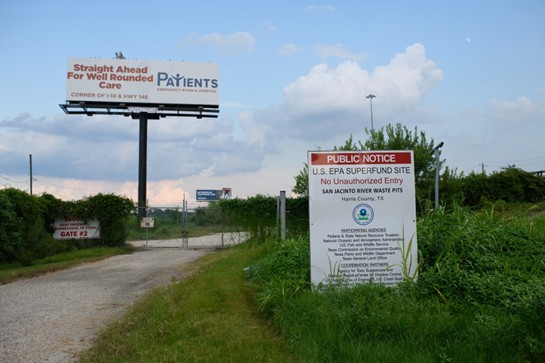
The sign in Channelview, Texas, warns passersby about the San Jacinto River Waste Pits Superfund site, located underwater and filled with dioxin-laced waste. Two billboards for nearby hospitals stand in the background.
By Sharon Franklin.
David Leffler, Public Health Watch recently reported on a Superfund site, where the Texas Department of State Health Services (DSHS) scientists conducted a study in East Harris County which is home to several environmental hazards, including toxic Superfund sites. These hazards are largely concentrated in certain communities, which is worrying its residents about concealed cancer clusters.
The DSHS investigation was requested by the Texas Health and Environment Alliance, (THEA), a nonprofit advocacy group led, Jackie Medcalf, who has suffered a litany of health problems during the decade she lived in the East Harris County community. It is her belief that these problems were tied to her home’s proximity to the Superfund sites. She experienced hair falling out, bleeding sores, seizures, and the lost of control of her extremities. Eventually, her doctors discovered 19 heavy metals in her body, including chromium, mercury and arsenic, all of which were found in the Superfund site.
Medcalf in a letter to DSHS on January 24, 2024, requested that scientists redo that study. She believed this request would validate her and other residents’ belief that toxic exposures were ruining people’s health in the Highlands and nearby communities. Medcalf exchanged dozens of emails and phone calls with DSHS scientists throughout the spring of 2024. However, by January 2025, she found out that the study had been stuck in DSHS’s “executive review” stage. On February 6, 2025, the state published the results, which examined 22 types of all-age cancers and three childhood cancers. In an interview, Ketki Patel, MD, Ph.D., MPH, Director, Environmental Surveillance and Toxicology Branch, Texas Department of State Health Services (DSHS) defended the agency’s decision to publish cancer data for a 250-square-mile area without providing details at the census-tract level. She said “the agency can’t release such data because, for some cancer types, it didn’t find enough cases to guarantee statistical reliability”. The DSHS study found that the Texas state average rates for:
- Leukemia were triple,
- Cervical cancer was 18% above the average,
- Lung and bronchus cancers were 17% above the average, and
- Lymphoma was 10% above the state average.
Public Health Watch shared (DSHS) assertions with epidemiologists, Nelson Kyle Steenland, Professor, Department of Environmental Health, Emory University Rollins School of Public Health and Philip Landrigan, a public health physician and professor at Boston College who studies the human-health effects of hazardous exposures. Landrigan stated “You don’t want to release [census-tract] information for a study like this if there’s fewer than five cases,” “But if you’re talking about lung cancer or leukemia, which is common in the population, then I see no issue whatsoever. You’re obviously not going to release names and addresses, but there’s no reason in the world why you could not release de-identified data.” Professor Landrigan and Steenland, were both in agreement that breaking down the new study’s data by census tract would have been a simple task, despite DSHS’s claims.
In April, 2025, THEA, held a pair of community events and invited DSHS to both events. THEA set up an table with balloons at both meetings, which drew notice to the agency’s obvious absence. Six weeks earlier, Medcalf held a joint press conference with Precinct 3 Harris County Commissioner, Tom Ramsey, who represents the Highlands and other communities located in the study area (Superfund site near Highlands). On September 8, 2025, Commissioner Ramsey, U.S. Rep. Sylvia Garcia and Harris County Commissioners Adrian Garcia and Rodney Ellis also sent letters to DSHS Commissioner, Jennifer Shuford urging them to hold meetings with residents about the current study, release an addendum with census-tract level data and commit to follow-up meetings with advocates and local elected officials once that information is released.
How Did DSHS Respond?
Confronted with the experts’ opinions, Patel, DSHS continued to insist that her team’s investigation followed standard practices maintained by DSHS and the Centers for Disease Control (CDC) as well as the new “CDC protocol”. Patel stated “Yes, leukemia cases were three times higher than the Texas average, but that isn’t an “exceptionally high” rate that would warrant “an in-depth epidemiological investigation.” Instead, the best thing to do is to “keep an eye on those types of cancers” in the coming years.
A Community Burdened by Chemical Waste Is Demanding Cancer Data Texas Health Officials Won’t Give It to Them. https://publichealthwatch.org/2025/10/09/texas-houston-chemical-waste-cancer/
Center for Health, Environment and Justice link to Superfund Information https://chej.org/superfund
